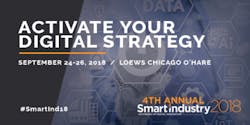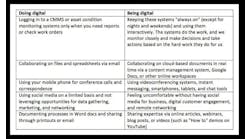What is digital intensity & how will it affect your enterprise?
On Day 2 of the 2018 Smart Industry Conference, Intel’s Dr. Irene J. Petrick, market innovation director,
Internet of Things Group, and Dr. Faith McCreary, principal engineer and user experience researcher, will co-present ‘Digital Intensity’ And Its Impact On Transformation. Today, they chatted with us about technology adoption, “seeing” into machines and the concept of the understanding gap. Take a look…
Smart Industry: How does one's role in the workplace affect acceptance of IIoT technologies?
Irene: When transitioning to the intelligent factory, leaders are often seen as decision-makers and workers are seen as being along for the ride. In our recent study, however, it was not just the manufacturing leaders or managers who proclaimed influence in adoption decisions. 56% of participating workers—drawn from the factory floor to the C-suite—saw themselves as decision-makers about the future of manufacturing at some level. And fully 98% of participants believe that they influence (either directly or indirectly) adoption decisions and implementation decisions at their company.
Faith: Worker participants who embraced technology and coming changes were often motivated by the desire to adapt as a way to stay relevant to their companies. Likewise, they wanted their factories to change in order for their company to remain competitive. Leadership participants who embrace technology are often concerned about the potential financial losses from poor adoption and delays from implementation. We also found a subset of leaders who appear to be more risk-averse that the workers on the factory floor when considering technology changes.
Smart Industry: What is a big misconception about how the IIoT will change how humans interact with industrial operations?
Faith: IIoT technologies in the factory will enable workers to “see” into their machines and into their overall operations, thus increasing transparency. This will enable humans to go from being problem fixers to being proactive problem solvers. Their jobs will become more strategic and will most likely have a larger span of control than current job roles and responsibilities envision.
Irene: A big misconception underlying this transition is that humans in the factory will go away. While we believe that automation will increase, there will still be roles that only humans can play—oversight roles. Our study participants agree with this perception, and while nearly all of the participants believe that the number of workers will be reduced, none of them believe that their specific job/role would go away. They do understand that they will need to continuously upgrade their digital skills to remain relevant, however.
Smart Industry: What most surprised you in the findings of your study on factorsIrene: The finding that surprised us most was the appetite for change across workers and leaders. In fact, 67% of participants expressed that the worst possible future state would be that no change happens—their companies and their jobs continue as they are today. 89% of our participants were ages 18-50, and we believe that this age demographic may explain some of this. These workers and leaders are not at or near retirement. They are users of technology in their personal lives and they expect that some of the benefits from connectivity, transparency and ease-of-use should translate into their work lives.
Faith: Another surprising finding is what we call magical thinking—participants in this study envisioned Industry 4.0 technologies, but see them in terms of a “black box” that somehow captures data and turns it into something useful by informing them or taking action on their behalf. They have a much more limited understanding of all the hardware, software and communications technologies that must come together to create intelligent-factory solutions. This leads to what we have dubbed the understanding gap. This is different from the more well-understood and expected skills gap. The understanding gap will be particularly important to bridge as managers and leaders try to implement solutions.
Smart Industry: We celebrate the opportunities created by smart technologies, but there are definite pain points in the adoption process. What did respondents of your study cite as most painful?
Faith: Participants are afraid of being ignored in adoption and implementation decisions. They point to previously adopted technologies that had little value or limited impact, often citing the lack of consideration for the way that new technologies fit into the existing system or the way that they change the worker tasks and other processes. Another pain point that study participants noted was their lack of trust with data. Many are afraid to trust what data is telling them to do and worry about the potential to lose control of key processes or decisions in the intelligent factory.
Irene: Without conscious efforts around change-management and worker-participation in the change process, both of these pain points are likely to persist with early adoptions of IIoT. As workers become more experienced with data being “right” (for example, predictive maintenance that is driven by machine-health-status data that reduces unplanned maintenance) trust in data will grow. There is going to have to be demonstrable factory-operations improvements that translate into business value before we see widespread behavioral changes.
Smart Industry: What is a main element of a leadership strategy for accelerating digital transformation?
Irene: Leaders are going to have to create a digital culture at their companies. They are going to have to exhibit leadership by example in data-driven decision making.
Faith: Leaders are also going to have to prioritize both communication with workers and training for workers.



